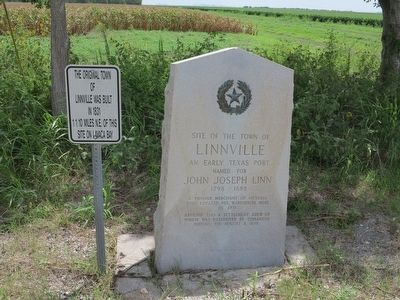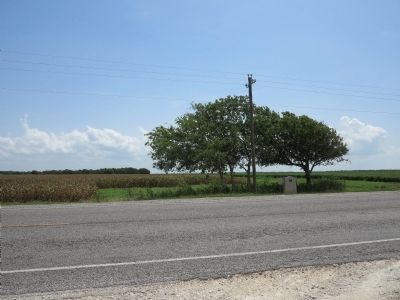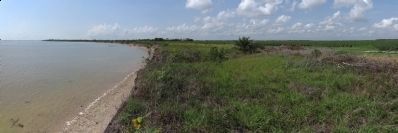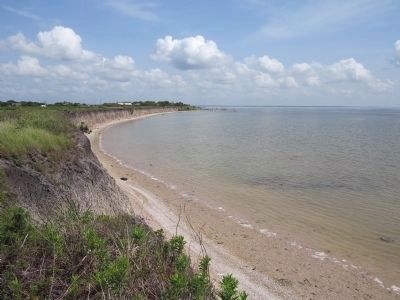Port Lavaca in Calhoun County, Texas — The American South (West South Central)
Site of the Town of Linnville
Inscription.
named for
John Joseph Linn
1789-1885
A pioneer merchant of Victoria
who located his warehouse here
in 1831
Around this a settlement grew up
which was destroyed by Comanche
Indians on August 8, 1840
Erected 1936 by State of Texas. (Marker Number 3091.)
Topics and series. This historical marker is listed in these topic lists: Native Americans • Settlements & Settlers • Waterways & Vessels. In addition, it is included in the Texas 1936 Centennial Markers and Monuments series list. A significant historical year for this entry is 1831.
Location. 28° 38.869′ N, 96° 39.152′ W. Marker is in Port Lavaca, Texas, in Calhoun County. Marker is on Farm to Market Road 1090, 1.8 miles west of Texas Highway 35, on the right when traveling north. Marker is located east of the Lavaca Masonic Lodge No. 36. Touch for map. Marker is in this post office area: Port Lavaca TX 77979, United States of America. Touch for directions.
Other nearby markers. At least 8 other markers are within 3 miles of this marker, measured as the crow flies. Port Lavaca Chapter No. 373 Order of the Eastern Star (within shouting distance of this marker); Lavaca Lodge No. 36, A.F.& A.M. (within shouting distance of this marker); Salem Lutheran Church (approx. 1.4 miles away); Springs of Calhoun County (approx. 1.6 miles away); First Presbyterian Church of Port Lavaca (approx. 2 miles away); First Baptist Church (approx. 2.2 miles away); Port Lavaca (approx. 2.2 miles away); Half Moon Reef Lighthouse (approx. 2.3 miles away). Touch for a list and map of all markers in Port Lavaca.
More about this marker. This marker was moved from its original location which was in close proximity to the town site on Lavaca Bay, but which is highly inaccessible. The book GHOST TOWNS OF TEXAS, copyright 1986, shows a 1982 photo of the marker in its original location.
Related markers. Click here for a list of markers that are related to this marker. These markers provide context in which the raid on Linnville occurred.
Also see . . .
1. Linville Raid of 1840. The Handbook of Texas, Texas State Historical Association (Submitted on July 6, 2014.)
2. Linville, TX (Calhoun County). The Handbook of Texas, Texas State Historical Association (Submitted on July 6, 2014.)
Additional commentary.
1. Context for the Raid in Republic of Texas History
The raid in August 1840 by Penateka Comanches, led by war chief Buffalo Hump, on Victoria and the Port of Linnville, on Lavaca Bay, Texas, is said to be the the largest raid by American Indians on cities in U.S. history (Texas was at the time still a republic). Linnville was sacked and burned by the Comanches, and the port was never rebuilt. Citizens of Linnville escaped to safety by taking to small boats and a schooner in the waters off the bay, watching as their town was burned to the ground.
The raid on Victoria and Linnville was one in a sequence of strikes and counter-strikes in Republic of Texas history that defined bitter relations between Comanches and Texans. See related markers link for information on each of these.
Events began with the Council House Fight in San Antonio, March 1840 in which Republic of Texas officials attempted to capture and take prisoner a large number of Comanche chiefs who had come to negotiate a peace treaty, killing them together with dozens of their family and followers.
The Comanche raid on Victoria and Linnville in August of 1840 was in revenge for the ambush at the Council House Fight.
The Battle of Plum Creek, near Lockhart Texas, shortly after the raid on Linnville, was Texans' retaliation against Comanches in their retreat from Linnville.
And
finally, The Comanche Village Massacre in Octorber 1840, was revenge by Texans for the raid on Victoria and Linnville by striking Penateka Comanches in their homeland near what is now Colorado City.
— Submitted July 5, 2014, by Richard Denney of Austin, Texas.
Credits. This page was last revised on June 16, 2016. It was originally submitted on July 5, 2014, by Richard Denney of Austin, Texas. This page has been viewed 1,456 times since then and 114 times this year. Photos: 1, 2, 3, 4. submitted on July 5, 2014, by Richard Denney of Austin, Texas. • Bernard Fisher was the editor who published this page.



